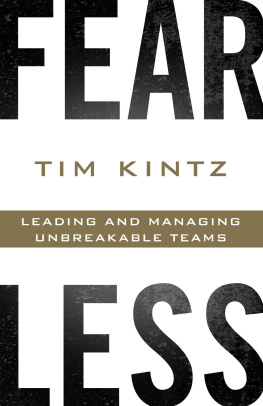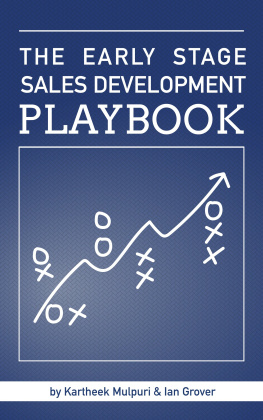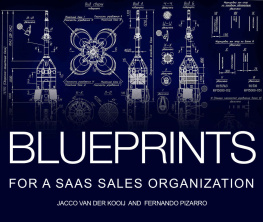Alea Homison - Leading Sales Development: The Art and Science of Building Exceptional Teams
Here you can read online Alea Homison - Leading Sales Development: The Art and Science of Building Exceptional Teams full text of the book (entire story) in english for free. Download pdf and epub, get meaning, cover and reviews about this ebook. year: 2019, publisher: BookBaby, genre: Home and family. Description of the work, (preface) as well as reviews are available. Best literature library LitArk.com created for fans of good reading and offers a wide selection of genres:
Romance novel
Science fiction
Adventure
Detective
Science
History
Home and family
Prose
Art
Politics
Computer
Non-fiction
Religion
Business
Children
Humor
Choose a favorite category and find really read worthwhile books. Enjoy immersion in the world of imagination, feel the emotions of the characters or learn something new for yourself, make an fascinating discovery.

- Book:Leading Sales Development: The Art and Science of Building Exceptional Teams
- Author:
- Publisher:BookBaby
- Genre:
- Year:2019
- Rating:4 / 5
- Favourites:Add to favourites
- Your mark:
- 80
- 1
- 2
- 3
- 4
- 5
Leading Sales Development: The Art and Science of Building Exceptional Teams: summary, description and annotation
We offer to read an annotation, description, summary or preface (depends on what the author of the book "Leading Sales Development: The Art and Science of Building Exceptional Teams" wrote himself). If you haven't found the necessary information about the book — write in the comments, we will try to find it.
Alea Homison: author's other books
Who wrote Leading Sales Development: The Art and Science of Building Exceptional Teams? Find out the surname, the name of the author of the book and a list of all author's works by series.
Leading Sales Development: The Art and Science of Building Exceptional Teams — read online for free the complete book (whole text) full work
Below is the text of the book, divided by pages. System saving the place of the last page read, allows you to conveniently read the book "Leading Sales Development: The Art and Science of Building Exceptional Teams" online for free, without having to search again every time where you left off. Put a bookmark, and you can go to the page where you finished reading at any time.
Font size:
Interval:
Bookmark:

Copyright 2019 by Alea Homison and Jeremey Donovan. All rights reserved. Printed in the United States of America. Except as permitted under the United States Copyright Act of 1976, no part of this publication may be reproduced or distributed in any form or by any means, or stored in a database, or retrieval system, without the prior written permission of the authors. ISBN 978-1-54399-458-2 eBook 978-1-54399-459-9
Introduction
T his is a book about the roles of art and science in building and cultivating high-performing sales development teams - teams that consistently deliver results, that successfully groom future AE talent, that become families of diverse talent, and that despite their success, are never satisfied.
If art seems like an unusual term to use in a business book, let us explain why it is important here. We like the term art because art is the creative way in which we apply what weve learned through our many years of combined experiences in strategy and sales at marquee enterprises and hyper-growth startups, including Credit Suisse, Abercrombie & Fitch, Gartner, GLG, AlphaSense, and SalesLoft. These learned experiences gave us the insight and ability to enjoy many business successes from which we are able to share with you here in what we call best practice. However, there were also some knowledge-building failures that were also important in adding to our knowledge that we will also share and refer to as lessons-learned. Another aspect that contributed greatly to this art of setting up high-performing sales teams comes from what we continue to learn through speaking with peers who lead sales development diverse companies. In addition, we would be remiss if we didnt share the great ideas we have been able to cull from other authors by voraciously reading as many sales books as possible.
The science comes from our academic foundations in business and engineering as much as it does from our skepticism. When evaluating ideas to test, whether from our own minds, those of our peers, or from books, it is common practice for us to question even the most basic assumptions because the stakes high. When we get things wrong, we put our companies at risk. But more than that, we put our sales development representatives (SDRs) at risk. For many of the people on our teams, this is their first or second job and we bear a deep responsibility to help them develop into tomorrows exceptional account executives and sales leaders. We take this responsibility of professional development seriously.
So you see, the marriage of art and science in this book happens when we validate an idea against academic research and commercial studies. Throughout the book, we will cite the studies that support or refute ideas for leading sales development and even delve into SDR math, particularly basic algebra and statistics. However, do not think of this book as a textbook. We wrote it in an accessible and casual tone. Just as we question everything in our lives, we made every effort to explain complex concepts in everyday conversational language assuming that you, our reader, shares in our curiosity.
Yet, this is also a book written by active practitioners for active practitioners. Compared with books written by sales consultants (many of which are excellent), we have no agenda other than providing guidance to elevate the B2B sales profession. We do not sell-from-the-page by directly or implicitly promoting ourselves or our companies. Nor do we claim to invent new methodologies by disingenuously renaming foundational frameworks, as do so many others.
As practitioners, we are also practical. By this we mean two things: First, we have no interest in being provocative for its own sake. For instance, pundits get up on their high horses to shout, Email is dead, long live Social Selling!, or Sell value, never features, or other nonsense. Taking a provocative position usually means embracing a false dichotomy - implying something is a strict OR when in reality it is an AND or simply depends on context. The truth is success requires email and phone and social and other channels. The truth is prospects care more about value than features at some points in the buying process and more about features than value in other parts. Second, we apply systems-level thinking. To be actionable, insights must be plugged into imperfect organizations that have constraints on people, process, and technology.
In order to be most effective, weve divided the book into three parts with each part aligned with a strategic and operational levers sales development leaders can control.
Part I focuses on the art and science of selecting talent. Here you will learn which traits actually predict success and which traits sound important but really do not matter. Youll learn how to properly screen and test for those traits and how to interview the right way (Spoiler Alert: The way most companies teach managers to interview ignores decades of academic research that proves conventional methods yield no better results than throwing darts at resumes, blindfolded!).
Part II focuses on setting new hires up for success. Even successful SDRs are only in their jobs for about 18-24 months before being promoted to account executives. As such, sales development leaders must build well-oiled systems to onboard, train, and motivate their teams.
Part III delves into the nitty, gritty of accelerating performance. We go deep on how to design multi-touch, multi-channel cadences and on how to drive and measure performance.
Although this book is written primarily for managers and directors of sales development, we also believe aspiring sales development leaders, sales development reps interested in the broader context of their discipline, and chief revenue officers will also find it valuable. And, if you are an account executive or revenue operational professional who geeks out on B2B sales like we do, then we know youll like it too.
Lets get started!
Contents
- Part I

Selecting Talent
Chapter
Identifying the Core Four Talent Traits
M any factors can lead you to succeed as a sales development leader, but none is more important than the ability to recognize and draft talented individuals.onto your team Make no mistake, there is more to this than just hiring warm bodies, never forget that you are selecting colleagues who are worth your investment of time, money, effort, and care. Keep in mind, too, that your team must generate quality pipeline at an acceptable cost of sales inclusive of overhead, such as management (thats you), tools, etc., and that you have 18 months, give or take, to develop people able to succeed as account executives once they are promoted.
Lets start by reflecting for a moment on your firms current hiring process. We are guessing it is semi-disciplined and looks something like this: Applicants reply to job postings through a variety of channels. Someone on your human resources team screens these applicants, though you are not exactly sure what questions they ask. Candidates who make it through the HR screening have an initial call with the hiring manager who is supposed to ask a prescribed set of questions. But what usually happens is this manager just got out of a meeting and barely had time to pull up the candidates resume, let alone find the questions to ask. As a result, the hiring manager follows their instincts when conducting this initial call to which this manager gives the thumbs up to proceed to the next hiring phase. Before returning for a day of interviews, the candidate is given a personality test that either isnt reviewed or has no bearing on hiring. Finally, the candidate comes in for a few final back-to-back interviews meant to have structure, perhaps to explore competencies, but dont and the interviewers again go on gut, give their thumbs up, HR checks the candidate supplied two references and, voila, the person is on your team.
Next pageFont size:
Interval:
Bookmark:
Similar books «Leading Sales Development: The Art and Science of Building Exceptional Teams»
Look at similar books to Leading Sales Development: The Art and Science of Building Exceptional Teams. We have selected literature similar in name and meaning in the hope of providing readers with more options to find new, interesting, not yet read works.
Discussion, reviews of the book Leading Sales Development: The Art and Science of Building Exceptional Teams and just readers' own opinions. Leave your comments, write what you think about the work, its meaning or the main characters. Specify what exactly you liked and what you didn't like, and why you think so.






